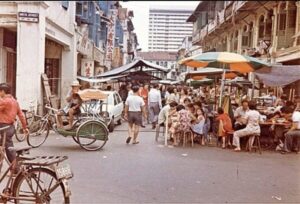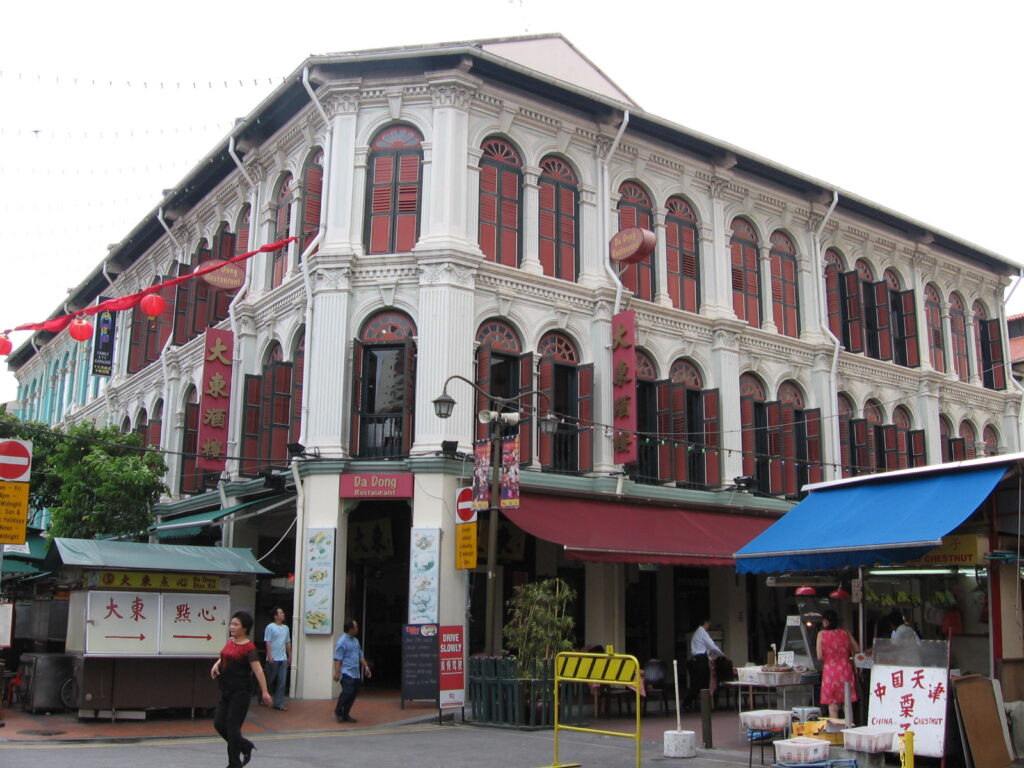If you stand at Smith Street in Chinatown, you probably have three questions in mind. First, what is Starbucks doing in Chinatown? Second, why is Smith Street called Chinatown Food Street with a glass roof above the closed road? And third, why is Smith Street the only street in the area named after a colonial figure?
Let’s start with the first question about Starbucks. Starbucks has very little to do with Chinatown’s history—it’s more likely just a competitor to Nanyang Old Coffee, located a little further down, or among the newer cafes that have recently sprouted. Today, Starbucks and joints like McDonald’s are everywhere. However, establishing a flagship store right in the heart of Chinatown’s historic streets can be seen as not a particularly positive sign—an indication of Chinatown’s waning image as a Chinese heritage site. For Starbucks, at least their effort to incorporate murals inside and outside the store helps it to blend into the area’s cultural vibe. The address at 37 Smith Street has seen various Chinese food tenants over the years—from an early tea house to Fatty Weng, and most recently Hao Lai Wu, a Chinese steamboat and BBQ restaurant that closed after less than a year. The current Chinatown Food Street initiative aims to revive the vibrancy of this iconic street, attracting more visitors. Institutions like the SLA, STB, and URA are seeking ideas and looking for a lead tenant to breathe new life into a street still recovering from the impacts of the Covid-19 pandemic.
This brings us to the second question: why is there a roofed street? Historically, Smith Street was the epicentre of Chinatown’s entertainment scene. It was home to an 834-seat Chinese opera theatre at No.36, highly popular in the early 1900s, serving as one of the few major entertainment venues of that era. It was the place to see and be seen, attracting the well-to-do and social elites. It is not surprising to note that, in 1901, at least 25 brothels were operating along Smith Street. Its principal attraction, however, was the lively convergence of street vendors and hawkers, offering food and goods throughout the day and night—earning it the reputation as the “street that never sleeps.”
 When the Kreta Ayer Complex (now Chinatown Complex) was completed in 1983, many hawkers and traders—including night market vendors along Smith and Trengganu Streets—were relocated there for hygiene and safety reasons. Unfortunately, this clean-up made Chinatown feel sterile and uninviting, as its vibrant street life is now tucked away into sheltered stalls. To revive the street’s lively atmosphere, the 100-meter stretch along Smith Street was converted into Chinatown Food Street in November 2001. It features hawker kiosks, shophouse restaurants, and temporary street stalls showcasing dishes from various Chinese dialect groups. The southern part of Smith Street is closed to traffic in the evenings. Later, it was renovated with the addition of a glass roof, large fans, and permanent closure to vehicles, turning it into a bustling outdoor dining area until its demise in Oct 2021, post-pandemic, never recovering from it.
When the Kreta Ayer Complex (now Chinatown Complex) was completed in 1983, many hawkers and traders—including night market vendors along Smith and Trengganu Streets—were relocated there for hygiene and safety reasons. Unfortunately, this clean-up made Chinatown feel sterile and uninviting, as its vibrant street life is now tucked away into sheltered stalls. To revive the street’s lively atmosphere, the 100-meter stretch along Smith Street was converted into Chinatown Food Street in November 2001. It features hawker kiosks, shophouse restaurants, and temporary street stalls showcasing dishes from various Chinese dialect groups. The southern part of Smith Street is closed to traffic in the evenings. Later, it was renovated with the addition of a glass roof, large fans, and permanent closure to vehicles, turning it into a bustling outdoor dining area until its demise in Oct 2021, post-pandemic, never recovering from it.
Finally, why is Smith Street the only road in the area named after a European? It’s named after Cecil Clementi Smith, who served as Colonial Secretary (and later Governor) of the Straits Settlements from 1878 to 1893. Coming from Hong Kong, he was tasked with addressing the rampant secret society activities in Chinatown. Smith understood the Chinese psyche and skilfully negotiated to ease tensions among rival clans and societies—many of which had clashed violently. He established the Chinese Advisory Board in 1889-1890, acting as an intermediary between the government and the Chinese community. His success in quelling conflicts earned him respect and admiration. He also introduced the Queen’s Scholarships in 1885, funded by the British government, to encourage talented local boys to pursue higher education in Britain. Over the years, many scholarship recipients returned as doctors, lawyers, and teachers—contributing significantly to society. So respected and loved was he that upon his retirement, the local community petitioned to keep him on as governor. Naming this street after him recognises his lasting contributions to the community and the broader development of Chinatown.


